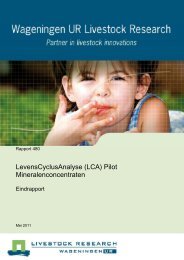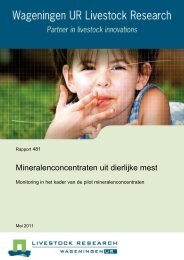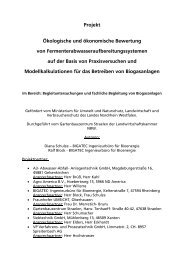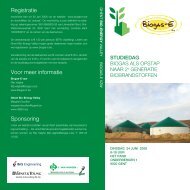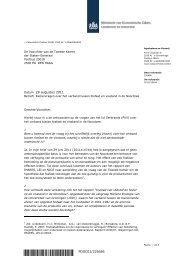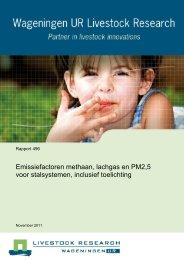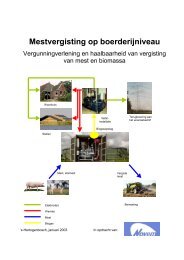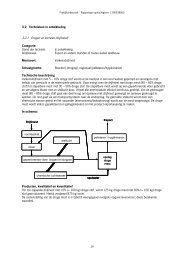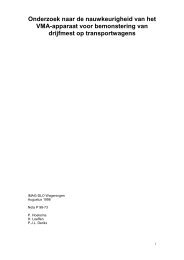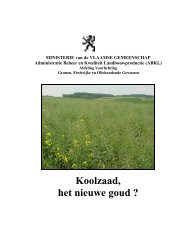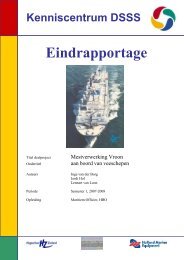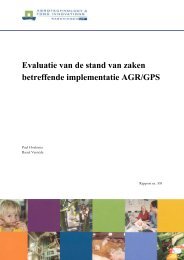Monitoring methane and nitrous oxide reduction by manure treatment
Monitoring methane and nitrous oxide reduction by manure treatment
Monitoring methane and nitrous oxide reduction by manure treatment
You also want an ePaper? Increase the reach of your titles
YUMPU automatically turns print PDFs into web optimized ePapers that Google loves.
Report 627<br />
1.3 Naturally ventilated building with clearly defined in- <strong>and</strong> outlets<br />
In naturally ventilated buildings with small <strong>and</strong> clearly defined inlet openings it is also assumed that the<br />
air in the animal house is mixed good. Emissions of greenhouse gases (CH4, N2O) can be determined<br />
<strong>by</strong> calculating the ventilation rate <strong>and</strong> measuring the greenhouse gas concentrations outside<br />
(background) <strong>and</strong> inside the building (in the outgoing air).<br />
1.4 Naturally ventilated building with undefined in- <strong>and</strong> outlets<br />
In naturally ventilated buildings with large <strong>and</strong> not clearly defined in- <strong>and</strong> outlet openings it is not<br />
possible to assume that the air in the building is mixed good. This makes it difficult to take<br />
representative air samples in the building, <strong>and</strong> measurements should therefore be performed outside<br />
the building. Besides, emissions are not directly measured, but determined <strong>by</strong> using calculation<br />
methods (see section calculation methods).<br />
1.5 Open air<br />
Different methods have been applied both in the Netherl<strong>and</strong>s <strong>and</strong> elsewhere to determine greenhouse<br />
gas emissions from outside <strong>manure</strong> storage facilities. These include enclosure techniques,<br />
micrometeorological techniques, tracer gas ratio methods <strong>and</strong> dispersion modeling (see section<br />
calculation methods).<br />
2 Emission measurements<br />
2.1 Measurement strategy<br />
The measurement strategy applied in the Netherl<strong>and</strong>s to measure emissions from animal houses<br />
takes into account the existing variation within <strong>and</strong> between farm locations with the same housing<br />
system, <strong>and</strong> variations in the measurement method used to perform the measurements. For animal<br />
houses the following measuring strategy is being adopted: six measurements spread over a year, on<br />
four different farm locations, with a minimum duration of 24 hours per measurement for NH3, CH4, N2O<br />
<strong>and</strong> fine dust <strong>and</strong> of 2 hours (between 10:00 <strong>and</strong> 12:00) for odour. Since little information is available<br />
for emissions from <strong>manure</strong> <strong>treatment</strong> installations, it is advised to start using a similar measurement<br />
protocol as for animal houses. Emissions from <strong>manure</strong> <strong>treatment</strong> installations with the same <strong>manure</strong><br />
<strong>treatment</strong> system may differ due to differences in amount <strong>and</strong> composition of the <strong>manure</strong> (<strong>and</strong><br />
eventually co-products) being treated. The emission of an individual installation may also vary in time,<br />
especially under the influence of the weather conditions. And the variation in measurement method<br />
due to inaccuracies of the measuring equipment will also play a role as for animal houses. This<br />
strategy may be adjusted if available measurement data show that the variation is larger/smaller than<br />
the one found in animal houses. Is the variation smaller, then a less extensive measurement strategy<br />
might be enough to provide an accurate emission factor for a particular <strong>manure</strong> <strong>treatment</strong> system.<br />
The stability of the <strong>treatment</strong> process may also affect the emissions from processes such as for<br />
example anaerobic digestion, <strong>manure</strong> drying or forced aeration. It is therefore included in the<br />
measurement strategy as prerequisite that the processing unit should be proven stable, i.e. with<br />
constant process parameters, over a period of at least 14 days prior to the measurements.<br />
2.2 Measurement methods<br />
An extended review of the different existing methods for measuring concentrations, ventilation rate (in<br />
animal houses) <strong>and</strong> emissions can be found in literature (Arogo et al., 2001;<br />
Hofschreuder et al., 2003; McGinn, 2006; Mosquera et al., 2002; Mosquera et al., 2005a; Neftel et al.,<br />
2006; Ni <strong>and</strong> Heber, 2001, Phillips et al., 2000; Van 't Klooster et al., 1994).<br />
34





